50-100 Tiger soldiers were killed in the failed attack by elements of the 53 and 55 divisions. As many as 200 have been wounded. The SLA casualties are actually harder to establish, with 100 dead at a minimum, and 185 dead at most. With "inside sources" to back every number in between, it is impossible to know the truth. What is accepted is that roughly 400 Sri Lankan troops have been wounded. No reports have been made on those who may have died of their wounds, on either side, though it is almost certain that some have succumbed to their injuries. Also lost were some Sri Lankan armored vehicles. Like all other figures from the battle, the numbers of damaged or lost vehicles varies from source to source, but including a damaged infantry fighting vehicle from the day prior to the attack, two to eight tanks and IFVs have been damaged or destroyed.
Over the years both sides have charged the other's defenses on the Jaffna Front. Most of these attacks have ended in failure for the aggressor, often with heavy loss of life. Since 2001, several SLA attacks have been made, all ending in defeat with hundreds of casualties. It is a situation very similar to the Battle of Fredericksburg in the American Civil War. The Sri Lankan military would do well to learn the history of that battle and the actions of the Union commander, Ambrose Burnside.
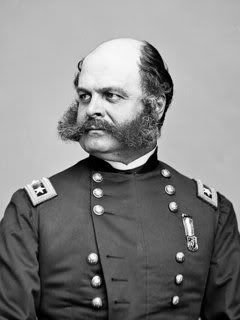
General Ambrose Burnside
Following the Confederate's successful escape from McClellan at Sharpsburg, President Lincoln put General Burnside in command of the Union Army. Burnside moved his vastly superior force to the East Bank of the Rappahannock River. On the opposite bank was the town of Fredericksburg, Virginia and the strategically vital Marye's Heights just beyond the town. Burnside planned to quickly cross the river, take the town, and capture the Heights before the Confederates could amass more than a skeleton garrison to defend the area. When Burnside reached the river, only 500 Confederates opposed him across the river, however, Federal troops were unable to take advantage of this numerical superiority, since they could not cross the river without pontoon boats, which had not yet arrived. Burnside refused to formulate a new strategy or objective for his army and opted to wait for the pontoon boats to arrive. It took 25 days for the pontoon boats to finally arrive and be deployed, in which time the better part of the Confederate Army had assembled West of Fredericksburg.
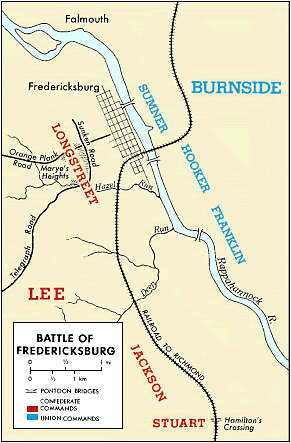
General Robert E. Lee ordered General James Longstreet's men to defend Marye's Heights, which made up the Northern half of the battlefield, while General Thomas "Stonewall" Jackson defended the Southern flank made up of fields, shallow creeks, and a rail line. Despite these 72,000 Confederate reinforcements, Burnside still had twice Lee's numbers.
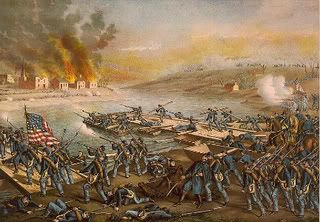
When the pontoon boats finally arrived, Federal engineers braved sniper fire from Fredericksburg to construct bridges, while Union artillery and an amphibious assault devastated the town to silence the rebel gunmen. Once the bridges were complete, Burnside crossed his army in force.
Once across the river, Burnside first attacked Jackson's force. The terrain was open, level, and neither side had permanent positions or fortifications. Burnside initially could use artillery from the opposite side of the river to support his advance, while the Confederates responded with aggressively handled horse artillery. Only two guns dueled the Union batteries for an hour, firing and moving faster than the Federals could react. A tactic the Sri Lankan military is all too familiar with. Union forces began making serious progress by mid morning and continued to push Jackson back until around 1:30. Fortunately for the Confederates, errors in coordination and insufficient numbers allowed Jackson to recover from his setbacks and counterattack, maneuvering between two Federal divisions that had become separated. The Union troops were pushed back and feared being trapped at the riverbank until additional reinforcements finally arrived and halted Jackson's advance. The fighting cost each side around 3,400 casualties. The majority of the Confederate losses for the whole battle occurred here, while the opposite would be true for the Federals.
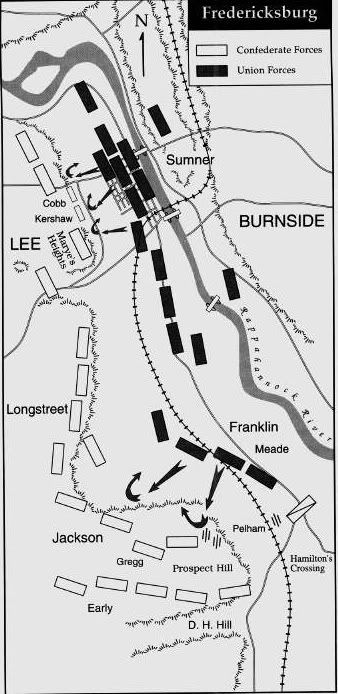
Troop movements at Fredericksburg
Burnside had squandered an opportunity to win the battle and defeat the legendary Jackson. Had the Federals put serious emphasis on Jackson, who had little artillery support, and no dug in positions, and attacked with the bulk of the Union Army, the Confederates would have had no means to hold the line against such a large force. Marye's Heights would have been flanked and Lee would have had to abandon his ideal defensive position or be surrounded. Instead, Burnside shifted his focus to Longstreet's dug in soldiers on the Heights.
Longstreet had the bulk of the Rebel artillery supporting his troops and had his infantry amassed along a sunken dirt road with a stone wall along one side. The result was a natural trench that gave excellent cover to his men while still allowing them a full range of fire. His concentration of force made any attempt to dislodge him an act of suicide. It seemed that everyone understood this, except Burnside. Confederate artillerist Edward Alexander
bragged to Longstreet that, "not even a chicken could live in that field when we open upon it."
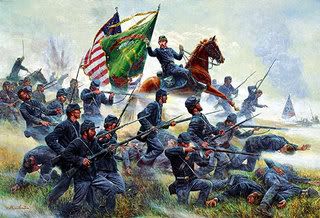
The famous charge of the Irish Brigade
Burnside Dedicated six divisions to taking the Heights, charging the Rebel position 16 times, usually in one-brigade charges. Although Longstreet was outnumbered, he held the high ground, was supported by artillery, and was well dug in. Each charge was easily repulsed with serious Union losses. It is here that the famous charge of the Irish Brigade was made. Advancing to within 50 feet of the stone wall, the 1,600 men of that fateful unit were cut to pieces by Confederate Irish troops of the Georgian Legion and only 256 men managed to escape. This courageous, but futile assault is made famous in the movie "Gods and Generals."
Watching the carnage, General Lee commented, "it is well that war is so terrible, or we should grow too fond of it."
1,200 Confederates were killed or wounded defending Marye's Heights. Over 10,000 Federals fell trying to dislodge them. It was one of the most one-sided victories of the war. Burnside had bungled the entire campaign, but the final cause of his defeat wasn't his inaction before the battle. It was his refusal to concentrate his forces where Lee was weakest and instead threw his army against the most secure piece of real estate in the Confederacy.
Sri Lanka would do well to remember Fredericksburg. The SLA needs to launch a major offensive, no doubt, but the location of such an offensive is as important as the action itself. Just as Burnside had a choice between Marye's Heights and the open terrain to the South of the battlefield, the Sri Lankan military has a choice between the bottleneck of the Jaffna Front, and the wide-open Southern Fronts.
3 comments:
"Sri Lankan military has a choice between the bottleneck of the Jaffna Front, and the wide-open Southern Fronts."
E.t. Bailey to simply say a major offensive along the Jaffna front is at a disadvantage to SLA due to a number reasons. If the SLA do make yet another offensive it has to be a very well coordinated/planned ofensive with the help of SLAF. SLAF is a must. Army should be prepared to lose 1000 men KIA and WIA.
I read your posts with lot interest. Keep up the good work :)
sldf,
to clarify, are you disagreeing that launching offensives from the Jaffna Front is a bad idea or do you agree with what I've written? I don't want to retype the whole article in a comment, but to say the least, terrain and numbers are critically important, but are not the only factors that make other avenues of approach more ideal. When the second section of this article comes out, some of these other reasons should be made clear to you. If not, I'd be happy to clarify.
I agree whole heartedly that the SLAF should be involved in supporting the SLA. When the second part of the Fredericksburg Articles is posted, which will hopefully be within the next day or two, the role of the Air Force will be a major point.
Thank you kindly. You should have something new to read before too long.
Post a Comment